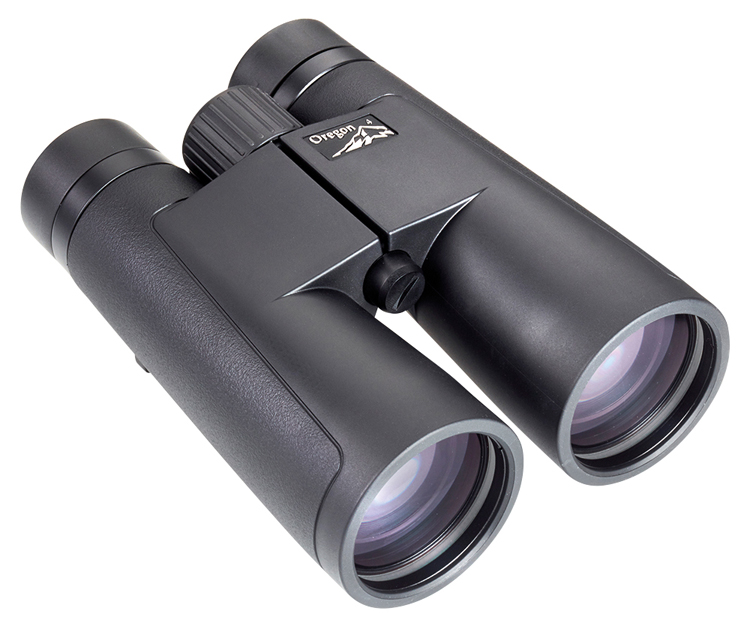Opticron’s Oregon 4PC Entry Level Binoculars
| Oregon 4 PC | Opticron | 8×42 | 5-Year Guarantee | Product Code: 30666 | RRP £106 |
The Technical Stuff:
Features
- Roof prism design with sophisticated twin relief rubber covering
- Nitrogen gas filled waterproof construction
- BAK 4 fully multi-coated optical system (all air/glass surfaces)
- Phase corrected prism coatings
- Twist type retractable eyecups
- Wide wheel focusing
- Full field of view wearing glasses
- Close focus to 2.3m
- Tripod adapter socket
Supplied Accessories:
Oregon 4 PC binoculars are supplied in a soft case with rain-guard, padded strap and rubber objective lens covers.
The Maker’s View:
The Oregon 4 PC nitrogen waterproof series offer the first-time or occasional user with a high standard of optical performance and functionality in a highly desirable and well-constructed body. With above average resolution figures and good colour contrast, the binoculars are a natural choice for almost all types of day time wildlife observation.
Fatbirder View:
These are Opticron’s ‘entry level’ binoculars… designed to give quality at a low price for those would who occasionally benefit from using binoculars or are new to a hobby such as birding where they will be frequently used as an introduction to the pastime.
It would be quite wrong to compare these to optics costing ten times as much, with lifetime guarantees and lots of birder appeal. You would need total conviction and very deep pockets to buy top of the range gear when first starting out or to keep in the conservatory to check out what’s at the feeders. I’m in the privileged position of having bins for most occasions with a pair in my study to check out the feeders and some permanently in the car so I don’t get caught out when NOT birding. I well remember the frustrations of the 1960s carrying optics which were meant for the bridge of a ship or the use of a tank crew. They were great heavy metal things with barely acceptable optical quality and a tendency to let in condensation and dust. When I returned to birding a couple of decades later I couldn’t afford Leica’s or Zeiss and had to settle for second-class optics, albeit far removed from Soviet Army issue!
Things have moved on a pace to a completely changed scene. For the equivalent outlay optical quality has moved orders of magnitude. Frankly, these days, it’s hard to find rubbish binoculars. Even the first tier of a couple of dozen companies offer acceptable pairs and the differences are marginal. I’ve tested a good few and there are just a few factors that separate the ‘not bads’ to the stars.
Durability is a consideration and at this end of the market don’t expect the bins to be pristine forever. If you get a five-year guarantee you are doing well. Look and feel is an area where there really is wide variance at this level. Buy wrong and you get skinny straps, dust-covers that go missing day one, bags not worth keeping without even looking at how they sit in the hand, close to your eyes or feel safe in your fingers. These Oregons score well on all of the above. Moreover, from reading old reviews I can see that Opticron took on board past criticism and changed whatever needed changing. A decent padded strap attaches easily and safely and when you’ve finished for the day they have a good quality bag to keep them safe. The rubberised bodies feel as good in the hands as most middle range bins at four times the price.
Of course, compared with the best they are a bit more clunky and there seems less fine tuning but at least you can quickly focus from near to far on a slickly responsive wheel. Of course, the sharpness, colour and across-lens clarity are not the same as the top range, but I believe they are as good as any at similar prices and better than a good few. If you are looking straight down the barrel, in good weather keeping the object in the centre of the lens you will be impressed with clarity and colour.
When I tested them out on a dull days at my local reserve my only frustration was that the lens edges were visible as image and colour did distort to an extent. These days I bird wearing spectacles and I found myself banging lens against lens as the image was best in the centre and I found it a tad difficult to keep the bins positioned so that I optimised that view. To my old eyes the image edges did seem to push toward yellow.
What is my overall opinion? Well, maybe I am biased but knowing the great after-ales response at Opticron I would certainly recommend them to occasional users and newbies. These will see you through your first year of birding and will not begin to frustrate until you are a more experienced birder chasing cryptic rares in the dying light of a bird race day.

